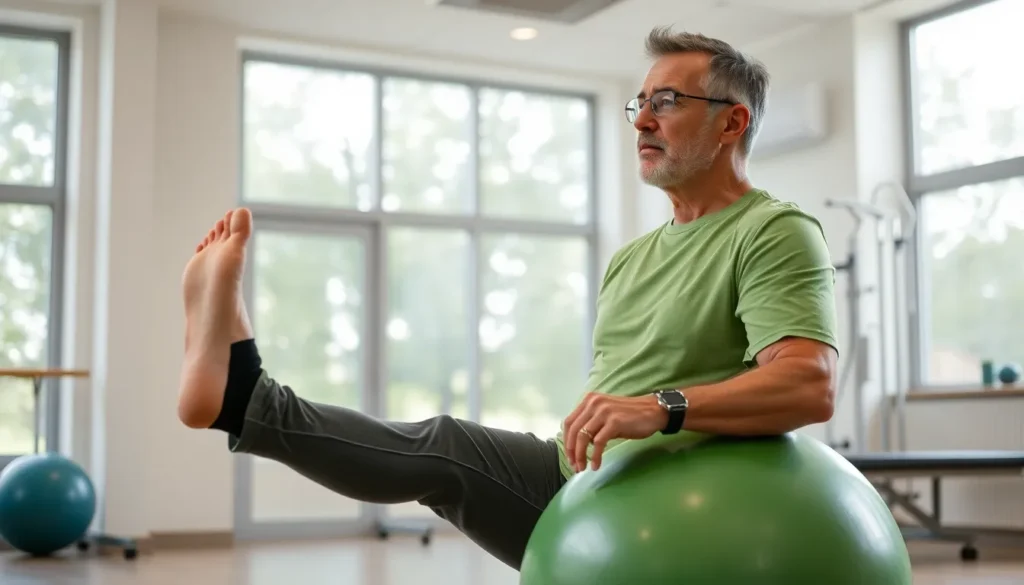Table of Contents
ToggleRecovering from hip replacement surgery can feel like waiting for a pot of water to boil—slow and sometimes frustrating. But don’t worry, it’s not all doom and gloom! With the right approach, this journey can be smoother than a well-oiled machine.
Overview of Hip Replacement Surgery
Hip replacement surgery involves removing damaged cartilage and bone from the hip joint and replacing it with artificial components. This procedure aims to relieve pain, enhance mobility, and improve the overall quality of life for individuals with hip joint issues.
Types of Hip Replacement Procedures
Surgeons perform mainly two types of hip replacement procedures: total hip replacement and partial hip replacement. Total hip replacement replaces the entire joint, including the femoral head and acetabulum. This approach often provides the highest level of relief. Partial hip replacement, sometimes used in certain fractures, replaces only the femoral head. Each procedure has specific indications based on the patient’s condition.
Benefits of Hip Replacement
Patients experience numerous benefits from hip replacement surgery, including significant pain reduction and increased mobility. Many individuals notice an improvement in daily activities, such as walking or climbing stairs. Long-term outcomes demonstrate enhanced joint function and decreased reliance on pain medications. With a successful procedure, most patients return to normal activities within a few months, leading to better overall physical health.
Factors Affecting Recovery Time

Multiple factors influence recovery time after hip replacement surgery. Understanding these elements can provide clearer expectations for patients during their healing process.
Age and Overall Health
Younger patients often experience quicker recoveries compared to older individuals. Overall health plays a significant role; those with preexisting conditions may face longer recovery times. Patients who maintain a healthy lifestyle generally return to their regular activities sooner. Additionally, mobility before surgery can impact how quickly one rebounds post-operation. Attention to nutrition, exercise, and pre-surgery fitness also matters. The body’s ability to heal is enhanced through good health and fitness levels.
Type of Hip Replacement
Total hip replacements typically involve a longer recovery period than partial replacements. The complexity of total hip replacements requires more extensive tissue healing. Conversely, partial replacements tend to be less invasive, which can lead to quicker recoveries. Surgeons select the type based on individual needs, and understanding the differences helps set expectations. More components replaced often translates to a more extended recovery timeline. The surgical technique used also influences healing rates and outcomes.
Rehabilitation Commitment
Rehabilitation commitment directly correlates to recovery speed and success. Active participation in physical therapy facilitates faster progress. Patients who follow recommended exercises and attend scheduled sessions tend to heal more efficiently. Motivation plays a critical role; those who remain dedicated to their recovery often experience better outcomes. Following the prescribed rehabilitation plan leads to improved strength and flexibility. Engaging with healthcare providers can further optimize the rehabilitation experience.
Typical Recovery Timeline
The recovery timeline following hip replacement surgery varies among individuals, influenced by factors like age and overall health. Understanding the stages can help manage expectations.
Immediate Post-Operative Period
Patients typically remain in the hospital for 1 to 3 days after surgery. During this time, healthcare providers monitor vital signs, manage pain, and begin physical therapy. Most individuals start walking with assistance within 24 hours. It’s crucial to follow post-operative instructions closely to promote healing.
Weeks 1 to 4
During the first month post-surgery, patients focus on mobility and pain management. Many individuals use crutches or a walker to aid movement. Physical therapy sessions generally begin within days, emphasizing strength and flexibility. By the end of week four, some patients might regain a significant range of motion and reduced pain levels, crucial for future recovery.
Weeks 5 to 12
From weeks five to twelve, developing strength is a primary goal. Most individuals engage in more intensive physical therapy, allowing significant progress. Daily activities become easier, with many returning to light tasks by the end of this period. Gradually, patients experience improved joint function, benefiting overall mobility and independence.
Beyond 12 Weeks
After the 12-week mark, many patients notice enhanced strength and stability. Continued physical activity plays an essential role in long-term recovery. Regular exercises help maintain mobility and prevent stiffness. At this stage, most individuals resume normal activities, contributing to overall quality of life. Regular follow-ups with healthcare providers ensure ongoing recovery support.
Strategies to Enhance Recovery
Implementing effective strategies can significantly improve recovery after hip replacement surgery.
Physical Therapy
Engaging in physical therapy is crucial for a successful recovery. Therapists develop tailored exercise programs that focus on restoring mobility and strength. Patients often start with gentle exercises soon after surgery, gradually progressing to more intense routines. Consistency in attending sessions and performing home exercises leads to faster recovery. Many patients notice improved confidence in their movements as they strengthen their hip joint. Ongoing communication with physical therapists helps identify challenges, ensuring adaptations as needed for optimal progress.
Home Modifications
Making home modifications eases the recovery process significantly. Installing grab bars in the bathroom increases safety during transfers and decreases fall risk. Rearranging furniture can create clear pathways to prevent accidents. Using a shower chair helps with bathing, minimizing strain on the hip. Additionally, elevated toilet seats allow easier access and comfort. Incorporating these changes simplifies daily tasks, boosting independence during the healing journey.
Nutrition and Wellness
Healthy nutrition plays an essential role in recovery speed. Prioritizing a balanced diet rich in protein, vitamins, and minerals supports tissue healing. Foods like lean meats, leafy greens, and whole grains provide necessary nutrients for recovery. Staying well-hydrated aids in overall health and helps maintain energy levels. Incorporating anti-inflammatory foods, such as berries and fatty fish, may reduce discomfort. Regular check-ins with a healthcare professional ensure nutritional needs align with recovery goals.
Recovering from hip replacement surgery is a journey that requires patience and dedication. While the timeline can vary greatly among individuals, most patients find themselves enjoying a significant improvement in mobility and quality of life within a few months. Engaging in physical therapy and maintaining a balanced diet play crucial roles in enhancing recovery outcomes.
It’s essential for patients to stay connected with healthcare providers throughout this process to address any concerns and ensure they’re on track. By committing to their rehabilitation and making necessary adjustments at home, individuals can pave the way for a successful recovery and a return to their daily activities.




